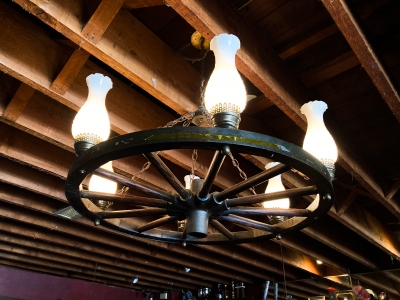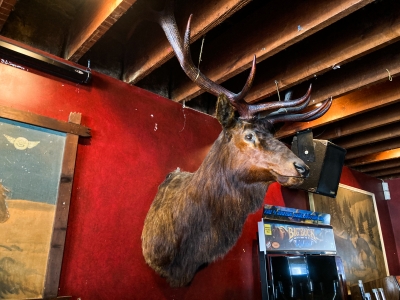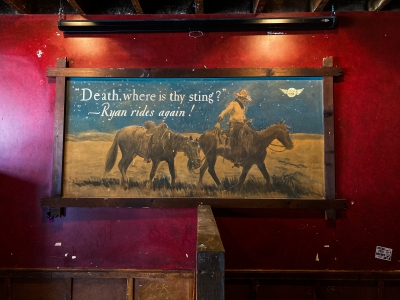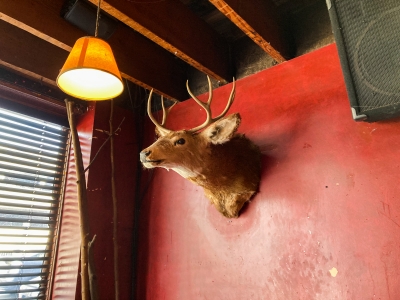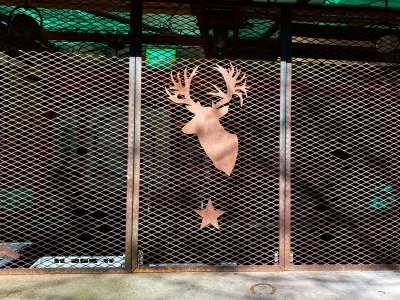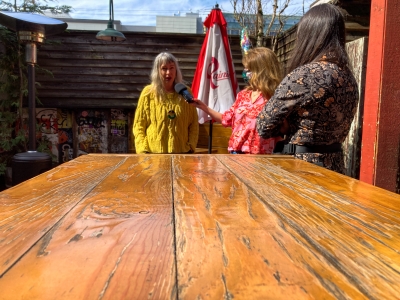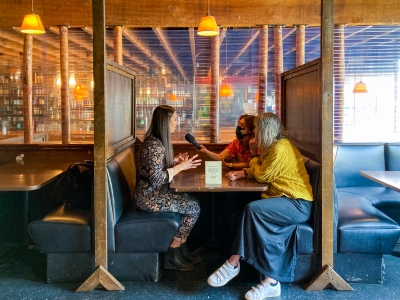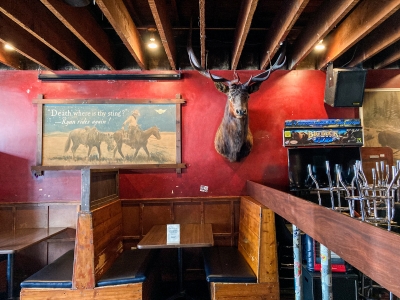
In this episode of Inspired Design, Linda Derschang, founder and CEO of The Derschang Group takes us on a wild trip down Seattle grunge memory lane and coins her iconic style High/Low. Learn how and why she uses storytelling to create her infamous gathering places. And wait, did she just say frosting, as in cake?
Episode Transcript
Linda Derschang:
I said, “Can you please find an avocado green, a pink, purple, some kind of colored sink?” I just think that sink is fantastic.
Gina Colucci:
I’m Gina Colucci with the Seattle Design Center. Every week on Inspired Design, we sit down with an iconic creator in a space that inspires them.
Linda Derschang:
Here we are in Linda’s Tavern.
Gina Colucci:
That’s Linda Derschang, the creative genius behind Linda’s Tavern on Capitol Hill.
Linda Derschang:
And it has looked pretty much the same since ’99, although it opened in 1994.
Gina Colucci:
Linda has opened 15 businesses over the course of her career, nearly all of them in Seattle. Oddfellows, King’s Hardware, Smith, the Bait Shop. The list goes on.
Linda Derschang:
I had a clothing store on Broadway, previous to owning Linda’s and my store was not doing particularly well. It had at one point. By ’92, ’93, there was a lot of competition, the neighborhood changing, et cetera. I was very good friends and still am with Jonathan Poneman from Sub Pop and friends with Bruce Pavitt. Nirvana had just started getting really big in, would that have been ’91, ’92? Anyway, it financially benefited Sub Pop, so going from a small, scrappy, super cool record label to a still small, scrappy, but very well known record label that actually had now some money happened in the early ’90s. Jonathan reached out to me and said, “Bruce and I have been thinking about opening a bar. What do you think? Want to do it with us?” That really was the beginning.
Gina Colucci:
A quick bit of history here. Bruce Pavitt started a fanzine called Subterranean Pop in the early 1980s as part of a class project at Evergreen State College in Olympia. He quickly began alternating issues of the fanzine with compilation tapes of underground rock bands. Jonathan Poneman joined the scrappy label in the late ’80s. It was not long after that, they released Love Buzz, their first Nirvana single. (music)
Linda Derschang:
When I was young, ’80s, ’90s, people weren’t called creatives. You were an artist or you weren’t. If I were a young person now I would say I’m a creative and how do I make a career out of that? But then, I really didn’t know. I just knew that I liked clothing, so I started my first business in 1984 with a woman that I was in a punk rock band with. We opened a store in Denver. We also had opened a coffee shop in Denver and the next thing we had planned on opening was a bar. Really, what we had in mind I suppose, was a little bit of a lifestyle brand. A clothing store, I could have easily imagined doing a store with furniture and housewares, a bar, a cafe.
Linda Derschang:
But the term lifestyle brand wasn’t around and we were just a couple of young punk rock girls, just thinking about the sort of businesses we would like to go to. I think that idea of creating businesses that I personally would like to go to, has carried through my whole career. So Linda’s really was the bar that Bruce and Jonathan and I, as we started discussing the project, we all had the same idea. It was the bar we wanted to go to. We wanted it to have this Northwest vibe. We didn’t want it to look like a theme bar and you have to be careful, there’s a fine line. But at the time, well, one: I had never designed a bar before, but I had spent time in dive bars. Of course, lots of bars, tons of bars.
Linda Derschang:
But had to really think about what makes a dive bar? This was a Middle Eastern restaurant. This was a full gut and rebuild, which was when I think about it now, that was bananas, even considering with the limited amount of design that I had done with my clothing store. We did work with an architect, but he kept saying, “Are you sure you want linoleum floors? And why do you want all this old wood? You’re going to go find used light fixtures?” Part of the thing was he was just someone that we happened to know, he was a great guy, but his whole look was very modern. He had designed the Gravity Bar, if you remember that.
Gina Colucci:
The Gravity Bar was a long ago, much loved juice bar and vegetarian spot on Broadway. It was open from ’86 to ’05 and was one of the first places to serve veggie green bowls and have wheat grass on the menu. People didn’t know what to make of it. It was such an anomaly. There were travel articles about the restaurant from publications all across the country and smoothies were a dollar.
Linda Derschang:
He was, I think, probably thinking, “Okay, she’s nuts, but I’m going to go along with this, it’s fun.” Actually, the guy that was the head construction dude on this project, it was this older fellow, Randy Jones. Randy Jones, I still remember him. He was in his 50s and he really got what I was trying to achieve. I kept saying, “Randy, I need to bring more things in that give it this woodsy vibe.” He came up with those big logs and turning them into shelves, that was Randy Jones. I found that cupboard in a salvage shop that had been in a pharmacy in Pioneer Square back in the day, it’s super old.
Gina Colucci:
The cupboard Linda mentions that was found in an old salvage shop makes you feel like you’re suspended in time. It fits perfectly with the aesthetic and it’s up over in the corner and they use it for storage.
Linda Derschang:
Graham Graham, who was working on Mo, which is now New Mo’s, had these extra booths and gave us the booths. They were in the basement of Mo. And I had some friends that were doing faux painting and I said, “I want the walls to look like burgundy leather.” You know what, I mean, now it’s looking pretty scruffy, but we’ve never repainted since 1994.
Gina Colucci:
I’m getting stared down by this taxidermy buffalo that is very iconic behind the bar. Does he have a name? Does she, I don’t even know? He, has horns. Have a name or what?
Linda Derschang:
No, but there are rules around the buffalo. They’re not allowed to put necklaces on it, they’re not allowed to put party hats, they’re not allowed to put cigarettes in its mouth. I really have a firm belief about the taxidermy here, but in all of the businesses that I’ve owned, that we need to respect the animal. They’re old, they had a life, that we’re honoring them by putting them in the businesses, I think. It’s not like we went out and shot a buffalo to make the bar look hip. However, when we opened in 1994, that buffalo freaked people out. It was the topic every single night I had to explain something about the buffalo. There were a lot of people that were horrified.
Linda Derschang:
No one at that time was putting taxidermy in their businesses. I’ve always really loved taxidermy, but I’d lived part of my life in Colorado. So there were these mountain bars that had antlers and taxidermy. I don’t know why I’ve always liked it, but I have. So there were times when people would ask about the buffalo and depending on how many times I’d been asked that week, I started sometimes telling people that yes, I had shot it. If they’re going to believe I shot that buffalo, okay. Anyway, most of the time I told the truth and said, “It’s old, it’s beautiful. We respectfully have it hanging up behind the bar.” But it seems so funny now that people would even question it. But it was a pretty big deal when Linda’s first opened.
Linda Derschang:
Later in my career, I had some haters on social media say some things about me copying some places in New York. That was when I designed Smith and during the beginning of Oddfellows. I said, “Look, go to Linda’s Tavern. We were using salvaged wood, salvaged cabinetry, old light fixtures, old paintings and taxidermy in 1994.” It’s a look that I like, but each one of my businesses has a slightly different look. The look that I always love is I think would be just considered high, low. You’re mixing old things, you might find things, you might thrift for certain things, and then you might drop a good amount of money on one light fixture. I don’t know, I just think that that makes a more interesting project.
Gina Colucci:
Is that explanation of the high, low, would you say that is your design style?
Linda Derschang:
I think it’s my clothing style, my design style, my lifestyle.
Gina Colucci:
Sounds fun to me.
Linda Derschang:
I mean, I’m in a, I think a $30 skirt from UNIQLO and a little bit of a fancier leather jacket.
Gina Colucci:
Talk about using used vintage light fixtures. Is there a story behind where you found some of these?
Linda Derschang:
Yes. For anyone who’s lived in Seattle for a long time, you will remember a store called Ruby Montana’s Pinto Pony.
Gina Colucci:
Ruby Montana’s Pinto Pony opened in 1980 and closed in 2000, when Ruby moved to Palm Springs. The vintage emporium was known for having high end furniture, alongside bargain, kitschy decor.
Linda Derschang:
The wagon wheel was from Ruby’s. In fact, a lot of the paintings on the wall, the Montana Power sign. There’s another painting up at the top of the stairs that was a gift from Steve Wells, who was the original owner of Rebar. He brought that to us. This photograph, the large black and white photograph with a herd of cattle, was found on the side of the road by a warehouse in Belltown. Some people brought it to us when we were opening and said, “We’ll trade this to you if we get free beer for the rest of our lives.” And I said, “Okay.” They moved to LA three years after we opened, so I probably got the better end of that deal.
Gina Colucci:
Probably, yeah.
Linda Derschang:
This big fella, this really big elk. In fact, I don’t know if it’s still the biggest, but at the time it was shot, it was the biggest in the state and it hung in Ernie Steele’s.
TV announcer:
Now let’s go to Philadelphia where the Eagles and the Cardinals fought it out for the National League championship in a blinding snow storm.
Gina Colucci:
Ernie Steele was a famed football player for the University of Washington and then with the Philadelphia Eagles. After his football career, he opened a bar and worked there for 46 years. He sold it in 1993 at the age of 75.
Linda Derschang:
There was an auction and I showed up at the auction and there were people that were so happy to see me and said, “Oh, Linda, we really hope you’re going to buy some of the taxidermy and put it in Linda’s.” That just really made me feel good that people wanted it to be moved down here because Ernie’s was… That was an iconic Seattle bar. Anyway, we have that elk, we had a ram’s head and it was hanging up there above our office door. It disintegrated a few years ago, so.
Gina Colucci:
Rest in peace. Linda’s is just brimming with artifacts from Seattle’s history. I’m shocked at how much stuff is from various iconic bars through the decades. While some relics are priceless, others didn’t age so well.
Linda Derschang:
This is the back of the payphone. Remember payphones?
Gina Colucci:
Yes.
Linda Derschang:
For many years, I thought that the payphone was stolen, it was just gone. And I said, “What happened to the payphone?” One of my employees said, “Somebody took it and the phone company doesn’t want to give us another one.” I’m like, “That’s crazy. Somebody stole our payphone.” Well, no, they just told me that. Then there was a point about five years later that I can’t remember which local publication was writing a story about things that were stolen in bars. They asked me about some of the things that had been stolen in our different bars and restaurants over the years and I told them about the payphone and it was published. One of the employees at Linda’s said, “Oh my God, you told them the payphone was stolen. It wasn’t stolen, the phone company came and took it back.”
Gina Colucci:
Everyone has a Linda’s story. I definitely have memories in this bar and there’s something about the energy of this place. I can’t quite put my finger on it, but I felt it as soon as I walked in the door.
Linda Derschang:
It’s just a special place. It really means something. For me, it’s the mid to late ’90s and certainly beyond that, obviously I’ve spent time here. But my main time of being here all the time and running Linda’s was ’94 to ’97 and then I started expanding my company. That was an incredibly magical time and I hear that from a lot of friends that are in my age range. But then there was a next group of people and it was a magical time for them and staff that worked here, and then a next group, and a next group, a next group. The thing that I think is so wonderful about Linda’s is that there are always young people.
Linda Derschang:
It’s kept this vibe, this feeling that it had in the ’90s, yet with different generations and each time there’s an amazing group of people. I’d like to think that that’ll just continue. Sometimes when I come in here and I look around and think, “Okay, well, if I were in my 20s or 30s, I would still love this place.” I love that it’s kept that, it still is a magical place for young people.
Gina Colucci:
Magical, indeed. There are so many stories here. Now we’re in your back patio, which is pretty amazing to have a back patio in the heart of Capitol Hill. What is your favorite spot about this area?
Linda Derschang:
The whole thing is amazing. I mean, it was a parking lot. When Linda’s first opened, we used it as a parking lot. Then within the first six months decided to try to create a patio back here and the landlord agreed. So it ended about halfway through the middle of what is now the current patio. I don’t think we even had the bar on the back until we did the big expansion, as a matter of fact. And at a certain point, and I don’t even remember what year it was, it could have been 2005. We expanded the patio, more than doubled it, built a bar on the back. We had the fellow who had done the original paint by number mural, come out and extend the mural, which was really great.
Linda Derschang:
Then one night, and again, I don’t remember what year it would have been, at least 10 years ago. Someone snuck in here, we don’t know what time and how they did it because there is an alarm system. But my manager called me the next morning and said, “You’re not even going to believe what happened on the back patio.” I’m like, “What?” He said, “The mural.” I go, “Oh, God, what? What happened to the mural?” Somebody frosted it. We didn’t know if it was paint or what they had done. It’s paint by number, so they painted it. The whole thing was painted. The staff went up to the paint and they were really careful, trying to figure out what it was and is this permanent and how did this happen? They scooped a finger full and then decided to taste it and it was frosting.
Gina Colucci:
Was it colorful frosting, like different colors?
Linda Derschang:
Yes, pink and purple and green, yes. Probably out of a can, I have no idea, did they buy canned frosting? Did they make frosting? They frosted the whole thing. But at that time we didn’t document everything on our phones. I’ve got a photo of it somewhere. These days, we’d probably leave it for a few days and let everyone come and Instagram it and see it. But then we thought, “Oh, we’ve got to get this cleaned up before it stains it, before anyone gets any ideas to come do something terrible.” Because sometimes if one person does it, a few more people. Maybe I shouldn’t even tell this story.
Gina Colucci:
I want to know who the staff member was to say, “Well, maybe I should try it.” Kudos for them. I mean, that’s brave. That’s so great. I can imagine it. I want to know how long it took them.
Linda Derschang:
I know.
Gina Colucci:
Was there more than one person?
Linda Derschang:
We have no idea. I mean, it was really bizarre and hilarious.
Gina Colucci:
Linda has designed so many spaces and infused them with soul and history. I wanted to know how she does that.
Linda Derschang:
To me, you’re telling a story and I think Linda’s really tells a story. I’ve told stories with other businesses, but I think that anyone can do that in their home. Even if you’re not trying to make a really designed apartment or house, if you are showing photos of places that you’ve been, or art that you bought on a trip, or furniture that you’ve bought, you’re creating these memories from places that you’ve traveled. Or if your interest is music and you have shelves of albums and a guitar sitting somewhere. That is telling the story of your home and your interests. I think that’s one of the things I love the most about design, is thinking of the story that you are telling if you’re actually doing it for a purpose, to create create a business.
Gina Colucci:
What story are you trying to tell at your new home in the Yucatan?
Linda Derschang:
Well, actually, that’s really an interesting question because I’ve had to think about it quite a lot. I started off thinking that it was going to be a little bit more beachy. Because I was thinking about Tulum and other beach places, beach towns that I’ve been to. And I realized, wait a minute, we’re in the middle of the Yucatan, so a beachy vibe, I mean, it would be fine if somebody wanted to do that. But I thought, “I don’t think I want to do that. I think I also want to really celebrate [foreign language 00:19:27] and the tiles that are used.” The traditional colonial look of the storefronts and the homes and how do I incorporate it into my funky little cinder block house? Which currently is undergoing having the roof taken off and they’re taking it up about three feet and then rebuilding all of that to give it more height and to give it a little bit more of a classic ’20s, ’30s look, so it will end up looking more like the other houses on my street.
Linda Derschang:
That’s another part of it, is making it really fit into the neighborhood as opposed to doing something that stands out. I want to embrace what the town is, rather than putting my own stamp on it. So I had to go back and forth between, okay, it’s a small town, it’s not a city. We’re not on the beach. What is the look and the feeling? What do I want people to feel when they come? What do I want to feel when I walk into my house? I want it to feel like a bit of an oasis. You’ve been out, either exploring pyramids, you’ve been out walking around the town and you walk through the doors and immediately you’re going to see the different pasta tiles. Which God, the tile is so good in the Yucatan, it’s so gorgeous.
Linda Derschang:
Then walk through and you will see a lap pool in the distance, but you walk through the area that is currently the original house and through a hallway. After you pass a couple of guests rooms, you’ll see to your left, an indoor courtyard and to your right, some stairs up to the main bedroom. Then walk into a room that will have casement windows and French doors and just cement floors and be very, very, very simple, that looks out to the pool and a wild garden, actually. I want it to look really natural in a lot of ways. I honestly can see the whole look in my head already. And it’s almost like a blurry photograph.
Linda Derschang:
This is how I think every time I’m doing a design project, it’s like a blurry photograph and you have to just slowly wipe away almost like Vaseline. You’re wiping away till you get to see the photograph completely clearly. If I do it right, it will end up as I’ve envisioned it. I think that’s always the trick, because sometimes you’ll go, “Oh, God, maybe I shouldn’t have chosen this particular thing, because I veered in a slightly different direction. How do I correct and veer in another direction?” I don’t preplan, whether it’s my businesses or my homes. A lot of it, it just starts happening, which can drive a contractor batty.
Gina Colucci:
Having a vision is one thing, but like Linda said, you still have to hire contractors and others to bring it to life. She told us her trick on how to make that work.
Linda Derschang:
When I was designing the Bait Shop, I thought about a fairly elaborate story for that design. The reason I did it was to explain to the contractor and his team, the vision, because I knew that it was going to be a hard one. It had been an Asian restaurant that had been remodeled. It had a polished cement floor and it was really upscale and modern looking. But I wanted to turn it into a bar that looked like it had been there since the early 1950s and a dive bar. So I had to convince the landlord that knotty pine walls were a great idea and that I was going to put linoleum on the beautiful, polished cement floors. And he’s like, “Really, I don’t know. I’m not feeling really good about this.” I was like, “Craig, come on. Trust me, it’s going to be good.” I mean, I have to say it was a bit of a battle to get him to let me do it. I said, “Look, you’ve been in my other businesses. Really, trust me.”
Linda Derschang:
The story was this. There was a guy that had been a fishermen and he was in his probably later 40s and he was ready to retire from fishing and he had saved some money, but not enough to hire anyone to build his bar. So he got his fishermen buddies and construction buddies all together and they built this bar called Bait Shop. Knotty pine walls and the horseshoe booths and linoleum floors and that fake paneling in the bathrooms. It was his dream bar, but because he was working on it with his buddies, it was a little funky. It wasn’t perfectly done, but it was really amazing.
Linda Derschang:
By the time 1970s rolls around, he would have been in his 60s at that point. So he had his son take over the bar, he was ready to step down. His son wanted to run it. His son was just a goofball and he had a Trans-Am. He took it out one night and he totaled his car and all that was left was the hood of the car. So he painted it and he hung it on the wall. Then he wanted to change the light fixtures that his dad had put up and he put these ’70s, mod light fixtures up. But he left the knotty pine and the linoleum and he stuck around for quite a long time and then finally he was ready to get out of it and we took it over.
Linda Derschang:
The construction guys were like, “But that, I mean, didn’t happen.” I go, “Look around, there are polished cement floors. We’re in a failed restaurant that was remodeled three years ago and went out of business. No, it didn’t happen. But that’s what we’re creating.” They’re like, “All right.” The main guy that owns the company was like, “Okay, here we go again.” He’d worked with me before. But his guys were like, “Oh, yeah. This is going to be rad.” When I told him about the fake paneling in the bathrooms, he was like, “That ’70s paneling, that stuff’s hideous.” I go, “I know, it’s rad. It’s going to look really good.”
Linda Derschang:
Anyway, I’m convincing somebody again. Always a man. Trust me, it’s going to be great. Anyway, the guys came to put down the linoleum and it looks very similar to the linoleum at Linda’s. These guys walked in and they did it on a Saturday and I was there and they’re like, “Wait a minute. Why are we putting this, I mean, we don’t mean to say it, we work for the company, but this is crappy linoleum on this polished cement floor?” I go, “Well, do you want me to tell you the story about the bar?” And they said, “Yeah,” so I told them the whole story. They’re like, “Oh, my God. This is rad,” and then they were super excited to do it. They got into it and the day they were putting the, I think it’s called beauty bark. I can’t remember the name of it, the ’70s fake wood paneling.
Linda Derschang:
The day that the guy was installing that in one of the bathrooms, I walked into the bathroom. This was a cool, tattooed, rock and roll dude. And I go, “Jeremy, is this bad, or is this just so cool?” And he looked at me and he goes, “Linda, this is so fucking cool.” I’m like, “Yeah!” Anyway, it was a really, really fun project. My sister came to town to visit and we were almost done with it and I was explaining this whole thing to her. And she was like, “But wait. Where are the people? I mean, how did you know to buy it from them?” I said, “Ginny, I told you, this is a made up story.” She’s like, “Where do you come up with these things?” She’s a French teacher and she teaches philosophy. I’m like, “I don’t know. I just make them up.”
Gina Colucci:
While the Bait Shop story is completely made up, the bonkers story Linda told me next is stranger than fiction.
Gina Colucci:
We’ve done a tour and gotten some little highlights. What’s your favorite story or most iconic night here that just is imprinted in your mind and will never leave?
Linda Derschang:
Oh, my God. I think it was when we had the Ron Jeremy Rum release party here. Yes, the distributor of Ron Jeremy Rum reached out to us and asked if we would have a party. When we met with them, they showed us photos of other parties that they’d had. They were in clubs, in dance clubs in Las Vegas or something. I’m like, “And you want to do this at Linda’s Tavern?” They’re like, “Yeah, we think it’d be really fun.” At the time I had this really awesome guy and he said, “Can we create the posters?” And they said, Sure.” So Jonah created this poster and it had an old image of Ron Jeremy when he was young and the poster said, “Ron Jeremy is coming,” and then Linda’s Tavern, whatever, June 12th, blah, blah, blah. They were all over the neighborhood.
Linda Derschang:
So I showed up here on a Friday night, he was already here. Patio was packed. There were a number of people that came just to meet Ron Jeremy. There were a number of people that just happened to be at Linda’s because it was a Friday night and they were approaching me saying, “Did you know he was going to be here?” I’m like, “This party was planned. Yes, we knew he was going to be here.” And Kelly O, who writes for The Stranger said, “Linda, you throw the best parties.” It was just an absurd night and just, I don’t know. It was just a weird, weird party. And having Ron Jeremy here, I don’t know. It was just a funny night at Linda’s.
Gina Colucci:
I can only imagine. It’s like that every night, right?
Linda Derschang:
Well.
Gina Colucci:
Linda’s career blows my mind. And I know it’s been a challenging year for her and everyone in the restaurant industry, navigating all the curve balls that the pandemic has thrown. And I had to ask, what’s next? What do you think is next for you?
Linda Derschang:
Oh, I know. I don’t want to open any more bars or restaurants, but honestly I’d planned that before the pandemic, because I’m a woman of a certain age and I really have worked very hard. This is a challenging industry and creating not only different interiors, but different concepts, from dive bars to nightclubs, to all day, all night neighborhood cafes, like Oddfellows, it’s been a lot. And it’s been a really, really fun career that I’m not ready to completely end. But I think that you’re constantly pushed if you’ve had some success to do more, do more, do more. And I did, and now I want to do less, less, less. Often people that are not business people, so not creatives, their focus is business say, “But what will you do?” Like somehow I’ll be bored. I have an apartment in New York. I could easily go to a few museums a week, go to lectures, see friends, ride my bike, take pictures. I need to learn Spanish, especially now I’m going to live in a small town in the Yucatan.
Linda Derschang:
I just think that if you’re a curious person, there are endless things that you can do to entertain yourself. I think I’ve done enough business. I’d rather think about the rest of my life as, I don’t know, a new adventure that I don’t necessarily want to monetize. I just want to enjoy and keep learning and exploring and creating.
Gina Colucci:
One of my favorite parts of this whole interview was learning about the infamous icing of the mural in the back of Linda’s. Do you have any leads of who did it or do you have a wild Linda’s Tavern story? I know we all do. Tell us by commenting on the Seattle Design Center’s Instagram post for this episode.
Gina Colucci:
Inspired Design is brought to you by the Seattle Design Center. The show is produced by Larj Media. You can find them at larjmedia.com. Special thanks to Meechie Suzuki, Lisa Willis, and Kimmy Design for bringing this podcast to life. For more, head to seattledesigncenter.com, where you can subscribe to our newsletter and follow us on social media.
Gina Colucci:
On the next episode of Inspired Design, we go behind the scenes with Nathan Myhrvold in his state-of-the-art photography lab and learn all about his latest projects.
Nathan Myhrvold:
You can see individual cells, so that’s how close up we’re getting. The thing I like about these photos is that they take a very familiar object and they show it to you in a very unfamiliar way. You can live your whole life, eating blueberries without ever really looking at a blueberry. So when you do look at it, you get to rediscover it in a new way.



